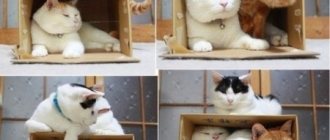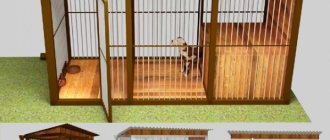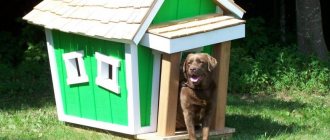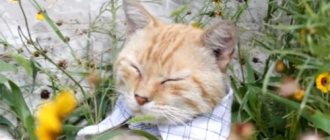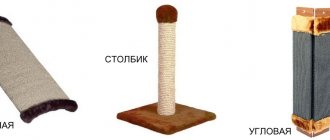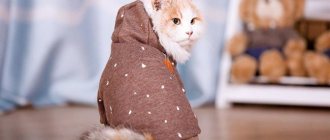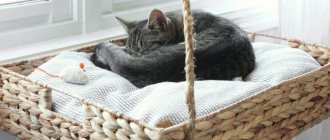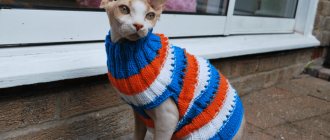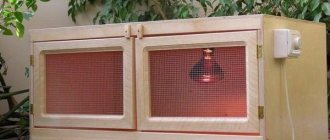We always wanted to have some kind of corner for the cat where she could jump and hide, something aesthetically pleasing, interesting for her and useful for us. As a result, inspired by the projects of other people, I made a play complex for cats with my own hands. I hope you like the climbing frame idea and also get inspired and enjoy the cute cat photos.
WHY DO YOU NEED A SCRATCHING POINT?
Houses for cats with scratching posts allow you to solve several important problems at once:
- provides the tailed pet with his personal place where he can retire at any time;
- minimizes the risk of “suddenly” discovering a four-legged animal lying on a table, shelves, sofa or TV;
- protects your doors and walls from cat claws, because the cat will use a scratching post;
- additionally decorates the interior of the room.
Since constantly sharpening their claws is a basic instinct of all cats without exception, it is useless to fight it. It is better to simply organize a special place for the cat for this - namely, a scratching post with platforms and a personal house in which she will spend a lot of time.
CONCLUSION
To minimize the consequences of living in the same house with cats, you just need to prepare a place for the tailed cats to play and relax. And there is simply no better option than a scratching post with beds and a hammock.
Before making a scratching post house, be sure to develop a design for the future structure and do not rush into assembly. Then you are guaranteed to succeed.
Write comments about how you have arranged a place for your pet to rest and play. Subscribe to content in terms of many interesting crafts.
Sincerely, Alexander!!!
A selection of photos of interesting cat complexes (houses)
This section is dedicated to interesting solutions that are embodied in the designs of cat houses, as well as entire complexes. It is not surprising that a person takes care of their pets, since, living next to a person for many years, they become members of the family. Such designs deserve attention!
DIY wigwam
The house in the form of a wigwam looks fresh and provocative . At home, you can quickly and easily build it from cardboard or fabric.
Wigwam for a cat made of cardboard
The following materials will be required:
- 6 twigs or branches - the basis of the frame. The upper ends are fastened together, the lower parts are widely spaced in different directions for stability.
- Scotch tape or rope - to secure the rods.
- Cardboard is the bottom of the wigwam. A hexagon is cut out and covered with fabric (preferably water-repellent).
- Glue or needle and thread - for holding fabric together.
- The fabric is cut into 6 isosceles triangles, in one of which a slot is made for the entrance.
The parts of the material are sewn together in such a way that rods can be inserted into the seam between the pieces of fabric. The frame is inserted into the stitched tent, and the bottom edges of the material are sewn to the bottom of the cardboard base.
Wigwam for cats made of fabric
Option 2: “complex with a play pipe”
This option is ideal for restless pets, since in addition to the house it includes several multi-level platforms and a play pipe suspended on a rope.
To implement the idea you will need:
- 2 pieces of plastic plumbing pipe D 50 mm, 1 m and 2 m long;
- 2 pieces of pipe D 100 mm, 2 m long;
- 20 meters of hemp rope;
- 2 plywood sheets measuring 800x1200 mm, thickness 10 mm;
- metal consoles measuring 100x150 mm;
- furniture stapler with a set of staples;
- a plastic bucket with a capacity of 20 liters for arranging a house;
- a plastic bucket with a volume of 15 liters for the construction of a play pipe;
- a piece of fleece for upholstery measuring 3x4 m.
Important point! To decorate the complex, it is better to use carpeting not with looped, but with cut pile. It is less traumatic for sharp claws getting stuck in the fibers.
Having decided on the dimensions of the structure, cut out blanks of appropriate sizes.
Cover each workpiece with material, using staples and glue to secure it. When winding pipes with hemp rope, secure the end by tying a knot and then screwing a self-tapping screw into it. This will extend the life of the rope wrap.
Mark at what level you plan to place the shelves. Attach the consoles in these places. Hide the tabs of the fasteners under the turns of the cord.
First remove the bottom from a shallow bucket, cover the walls and ends with carpet. Cover a large plastic bucket with material on the inside and outside. Foam rubber can be used as an inner layer.
Fix the house in the center of the bottom at the end of a 2-meter pipe using metal corners.
At the final stage, all that remains is to “plant” the shelves on metal flanges and attach them to the pipes. It is better to decorate the joints with the remnants of the carpet. Hang the play tube on twine directly above the wide shelf.
Tip: to increase the rigidity of the structure, it is better to additionally fix the shelves adjacent to the wall using corners or consoles.
Built into furniture
Enterprising owners can come up with anything they can, and often adapt existing furniture into a cozy pet’s refuge .
The following pieces of furniture can be turned into a cat house:
- a cabinet or small cabinet (bedside), cutting out a passage in the door;
- a sofa by attaching cardboard or fabric tunnels to it, or placing a shelf with a lounger on the side;
- a bookcase with a ladder attached so that the cat could use it to get to the very top and hide there;
- a table or chair with a soft fabric hammock secured under it;
- table, making an additional lower shelf with a lounger, pillow;
- open shelves of cabinets, placing beds or low baskets or boxes on them;
- shelves for flowers, setting aside the bottom shelf for the pet and the top for flowers.
For such transformations you will need simple tools that can be found in any home:
- scissors, needle and thread;
- hammer, nails;
- screwdriver, self-tapping screws;
- jigsaw (manual or electric);
- glue, stapler for furniture.
House for a cat from a chair
What materials?
A cat house is usually made from leftover building materials or other elements that are no longer needed. This is quite acceptable, since all structural elements will have to be covered with fabric, some other textile, or wrapped with ropes. Despite this, even such materials have a number of requirements.
Due to this:
- They should not have any foreign, especially pungent, odors. In any case, those living in the house should not feel it, and animals even less so, since their sense of smell is much sharper. If these are natural odors, then they are allowed. If any material still has a bad aroma, then you can leave it outside for a while.
Not harmful materials - Do not use materials that tend to accumulate electrical charges. These include open surfaces made of plastic, materials made of wool or silk. Animals are quite sensitive to electrical discharges.
In order for a cat to begin mastering this complex as quickly as possible, it needs to be kept in the home for some time. This is necessary so that the structure completely absorbs the aromas of the room familiar to the animals.
Basic materials
A cat complex can consist of several elements, which are made from various available materials. That's why:
- The house can be made from plywood, chipboard, thin boards, woven from twigs, from newspaper tubes, etc.
- Vertical and inclined elements are manufactured:
- From plastic pipes for sewerage, from paper pipes, which can be placed in a tree trunk, in a wooden beam, or wrapped with a piece of linoleum.
- From ordinary boards, chipboard or fabric, placing them at different angles.
- Hammocks are made of fabric, ropes, and a regular wooden slatt is used as a frame.
Platforms are made of wood, chipboard, plywood, etc. If the platform is made of wood, then it does not need to be covered with fabric, but it will have to be sanded and also coated with water-based varnish. If the material is chipboard or plywood, then it is better to enclose them in fabric, since chemical components are used in their manufacture.
Platforms made of wood and plywood
It is permissible to take a tree trunk as the basis for a cat complex, but there is no need to remove the branches completely, leaving some of them in order to attach platforms, a house and other elements to them. To do this, take a tree trunk about 2 meters high, after which the branches are cut off so that 20-30 centimeters remain. After this, the bark is removed from the trunk. Such a complex for animals will be especially interesting, since it has a natural base, but we must not forget that it needs to be well strengthened.
Sheathing material
To get a scratching post, just wrap a thick rope made of natural material, such as hemp, for example, around the base. If the complex is not made of wood, then it will have to be completely wrapped with rope, so it will take quite a lot of it.
To sheathe houses and shelves, you can use a dense material such as carpet, but you should not use carpet with a long pile. The long pile facilitates the rapid collection of dust and dirt, along with animal hair. In turn, this can cause allergic reactions, both in the cats themselves and in the residents.
Carpet upholstery
The color of the upholstery does not matter at all, especially for cats, but for the owner this is an interesting question, since the best option is a combination of the color of the cat complex with the interior of the human home.
Fastening
The most important thing is that the design is absolutely safe for the animal. All fastening elements must be hidden, and if necessary, they are covered with putty or sheathed with fabric.
Cat climbing frames with platforms
Equally important is to securely secure the entire structure, especially if it is used by more than one cat. Their games can lead to the fact that the entire structure may collapse, and the higher it is, the greater the likelihood.
WHAT'S BETTER: A HOMEMADE SCRATCHING POT OR A PURCHASED SCRATCHING POINT?
Despite the fact that stores offer a huge range of different designs, a self-assembled scratching post is the most acceptable option. There are several reasons for this:
- affordable price. If you make it yourself, your costs will be 7–10 times lower than the cost of a similar design in a store;
- the ability to create any configuration. Whatever one may say, most store-bought products are universal and differ little from each other. A scratching post assembled by yourself will fit perfectly into the configuration of the room and the interior, and will not look alien;
- reliability and durability. Often store structures are made using the most inexpensive and short-lived materials. As a rule, such a scratching post lasts no more than 1–2 years, after which you have to purchase a new one. A structure made according to all the rules with one’s own hands can easily last for decades;
- efficiency of production. If you need a cat house of a personal configuration, then to purchase it you will have to contact the manufacturer to change the basic design and manufacture a new scratching post model. This is not only financially expensive, but can also last for several months. While you can make it yourself in a few days, and if the design is extremely simple, then in a few hours;
- safety and hygiene. It is difficult to be completely confident in the environmental friendliness of the materials used for the production of store-bought scratching posts. After all, with active use, threads and small fibers may remain from low-quality rope. A cat can easily choke on them, and litter lying in a continuous layer on the floor is unlikely to add aesthetics to the room. In addition, it is impossible to know for sure how materials are processed in production - but toxic varnishes and paints can be applied to them.
In other words, if you want a high-quality, durable and safe scratching post for your four-legged pet, then it is better to make it yourself. That’s what I did, and it turned out much better compared to store-bought products.
Peculiarities
So, to prevent Murka from choosing some unsuitable place to sleep, you need to take care of creating her own corner, and it is advisable to take into account the individual characteristics of the cat. So, some animals prefer to climb as high as possible, while others, on the contrary, try to crawl under a closet or bathtub. The love for tall objects is explained by instincts: when a predator can look down on its fellows, it feels in a more advantageous position, and the air temperature at an elevation is usually higher, since warm air rises. For those who like to take a position at the top, a house on a pole is ideal.
Why do cats sharpen their claws?
Once upon a time, cats were wild animals, and also predators, which they remain to this day. In the struggle for survival in a cruel nature, they had to carefully monitor their “weapons” - their claws. After all, whether the hunt would be successful depended on how sharp they were.
The danger of starvation or death had passed, but the primary instincts remained. Cats continue to sharpen their claws, clearing them of the keratinized top layer in order to free the overgrown young plate. And for this you need a fairly hard surface, like trees, for example.
Today, the habitat of cats is no longer wild forests, but a cozy apartment, and trees can easily be replaced with furniture or wallpaper. All a person can do is offer cats a worthy replacement in the form of scratching posts.
In addition, sharpening claws is a physical exercise, and the location of the claw depends on which muscle group will be involved in the process. Therefore, it is advisable to provide the animal with more than one “equipment”, but to create a mini-gym from several items.
Dimensions and shape
In order for a cat to want to live in a house made for it, you need to take into account a number of points
It is important not to make a mistake with the dimensions of the product: they must necessarily correspond to the parameters of the animal. The main thing is that the pet fits in this structure, lying on its side, and ideally it should have enough space for stretching after sleep, and for a claw point
For a pet of average parameters, a cubic structure is suitable, the width of which will be at least 50 cm, and the height – from 30 cm. Then the entrance should have a width of no more than 15–20 cm, otherwise the animal will not feel safe.
Age
It is better to make not just a house for kittens, but a play complex. Such animals are active and require room to move. Older cats are calmer, and classic housing in the form of a house with a flat or 1-2 pitched roof is suitable for them.
Habits
If the animal is an adult, then it will not be able to change its habits, so when making a new house you need to try to preserve as much as possible the dimensions, location of the entrance and other parameters of its previous home.
Bed
A cat bed can be made of cardboard, newspaper tubes, or foam rubber. The shape of this resting place is selected in accordance with the size of the cat or its preferences in relaxation.
Cat bed made from an old sweater
Some prepare beds similar to the existing interior in the apartment. The main thing in this matter is to provide your pet with comfort and warmth. Therefore, do not forget about using foam rubber, soft fabric and other textile materials.
Soft fabric bed
